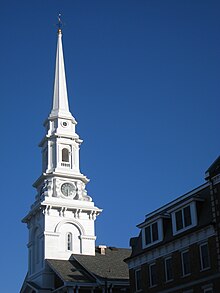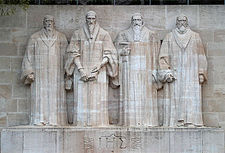Our website is made possible by displaying online advertisements to our visitors.
Please consider supporting us by disabling your ad blocker.
Congregationalism in the United States

| Part of a series on |
| Reformed Christianity |
|---|
 |
|
|
Congregationalism in the United States consists of Protestant churches in the Reformed tradition that have a congregational form of church government and trace their origins mainly to Puritan settlers of colonial New England. Congregational churches in other parts of the world are often related to these in the United States due to American missionary activities.
These principles are enshrined in the Cambridge Platform (1648) and the Savoy Declaration (1658), Congregationalist confessions of faith.[1][2][3] The Congregationalist Churches are a continuity of the theological tradition upheld by the Puritans.[4] Their genesis was through the work of Congregationalist divines Robert Browne, Henry Barrowe, and John Greenwood.[5]
Congregational churches have had an important impact on the religious, political, and cultural history of the United States. Congregational practices concerning church governance influenced the early development of democratic institutions in New England. Many of the nation's oldest educational institutions, such as Harvard University, Bowdoin College and Yale University, were founded to train Congregational clergy. Congregational churches and ministers influenced the First and Second Great Awakenings and were early promoters of the missionary movement of the 19th century. The Congregational tradition has shaped both mainline and evangelical Protestantism in the United States.
In the 20th century, the Congregational tradition in America fragmented into three different denominations. The largest of these is the United Church of Christ, which resulted from a 1957 merger with the Evangelical and Reformed Church. Congregationalists who chose not to join the United Church of Christ founded two alternative denominations: the National Association of Congregational Christian Churches and the Conservative Congregational Christian Conference.
- ^ Rohr, John Von (4 August 2009). Shaping of American Congregationalism 1620-1957. The Pilgrim Press. ISBN 978-0-8298-2077-5.
Although the Savoy Declaration's confessin of faith was based largely upon that of Westminster, the section entitled "The Institution of Churches" became an important late seventeenth-century document depicting the congregational form of church order.
- ^ Fields, C. Ryan (6 February 2024). Local and Universal: A Free Church Account of Ecclesial Catholicity. InterVarsity Press. ISBN 978-1-5140-0672-6.
After the doctrinal exposition there follows a section titled "The Institution of Churches, and the Order Appointed in Them by Jesus Christ," which further specifies how their polity differs from the Presbyterian divines.
- ^ Davie, Martin; Grass, Tim; Holmes, Stephen R.; McDowell, John; Noble, T.A., eds. (21 April 2016). New Dictionary of Theology: Historical and Systematic (Second Edition). Inter-Varsity Press. ISBN 978-1-78359-457-3.
Cambridge Platform (1648) and Savoy Declaration (1658) were the fundamental formularies of, respectively, American and English Congregationalism. In doctrine they essentially reproduced the Westminster Confession, with the changes needed to provide for a church polity of independent congregations (Schaff; Leith; W. Walker, The Creeds and Platforms of Congregationalism, New York, 1893).
- ^ Melton, J. Gordon (2005). Encyclopedia of Protestantism. Infobase Publishing. p. 161. ISBN 978-0-8160-6983-5.
- ^ Pastoor, Charles; Johnson, Galen K. (28 September 2009). The A to Z of the Puritans. Scarecrow Press. p. 84. ISBN 978-0-8108-7039-0.
Previous Page Next Page


